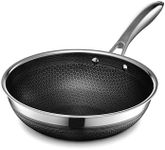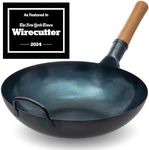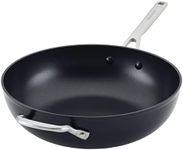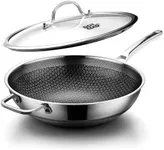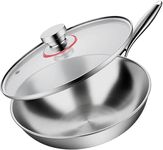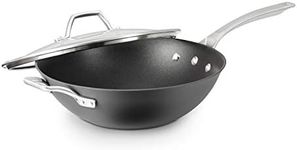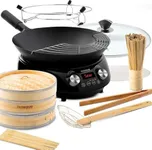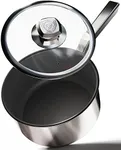Buying Guide for the Best Wok For Induction
Choosing the right wok for your induction cooktop can significantly enhance your cooking experience. Induction cooktops require specific types of cookware that are compatible with their heating technology. When selecting a wok, it's important to consider several key specifications to ensure it meets your cooking needs and works efficiently with your induction cooktop. Here are the key specs to look for and how to choose the best one for you.MaterialThe material of the wok is crucial because induction cooktops require cookware with magnetic properties. The most common materials for induction-compatible woks are cast iron, carbon steel, and stainless steel with a magnetic base. Cast iron retains heat well and is great for slow cooking, but it can be heavy. Carbon steel heats up quickly and is lighter, making it ideal for stir-frying. Stainless steel is durable and easy to clean but may not heat as evenly as cast iron or carbon steel. Choose a material based on your cooking style and preference for weight and maintenance.
Base CompatibilityFor a wok to work on an induction cooktop, it must have a flat base that makes full contact with the cooktop surface. A flat base ensures efficient heat transfer and stability during cooking. Woks with round bottoms are not suitable for induction cooktops unless they come with a flat-bottomed adapter. When selecting a wok, ensure it has a flat base that matches the size of your induction cooktop's heating element for optimal performance.
SizeWoks come in various sizes, typically measured by their diameter. Common sizes range from 10 to 16 inches. The size you choose should depend on the amount of food you plan to cook and the size of your induction cooktop. A 12 to 14-inch wok is versatile and suitable for most home cooking needs, providing enough space for stir-frying without overcrowding. If you cook for a larger family or entertain often, a larger wok might be more appropriate. Conversely, a smaller wok is ideal for single servings or small kitchens with limited storage space.
Handle TypeWoks can have one long handle, two short handles, or a combination of both. A long handle allows for easy tossing and stir-frying, while two short handles provide better stability and are easier to lift when the wok is full. Some woks also come with a helper handle opposite the long handle for added support. Consider your cooking style and comfort when choosing the handle type. If you frequently stir-fry, a long handle might be more convenient. For heavy dishes or if you prefer more control, two short handles or a combination might be better.
WeightThe weight of the wok affects its ease of use and heat retention. Heavier woks, like those made from cast iron, retain heat well and are excellent for slow cooking and searing. However, they can be cumbersome to handle, especially when full. Lighter woks, such as those made from carbon steel, heat up quickly and are easier to maneuver, making them ideal for quick stir-frying. Consider your strength and cooking style when choosing the weight of your wok. If you prefer quick, high-heat cooking, a lighter wok may be more suitable. For slow-cooked dishes, a heavier wok might be better.
CoatingSome woks come with a non-stick coating, while others are uncoated. Non-stick woks are easier to clean and require less oil, making them a good choice for healthier cooking. However, they may not withstand high heat as well as uncoated woks and can be prone to scratching. Uncoated woks, such as those made from carbon steel or cast iron, develop a natural non-stick surface over time with proper seasoning. They can handle higher temperatures and are more durable. Choose a non-stick wok if you prioritize easy cleaning and low-fat cooking. Opt for an uncoated wok if you prefer high-heat cooking and don't mind the extra maintenance.
